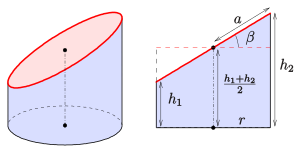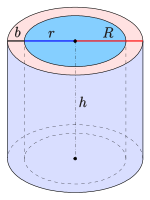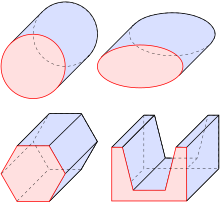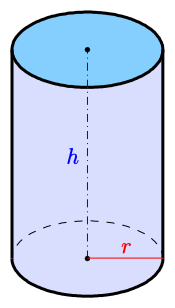Cylinder
A cylinder (Latin cylindrus, ancient Greek κύλινδρος kýlindros, from κυλίνδειν kylíndein 'to roll', 'to roll') is in the simplest case a
- Surface whose points have the same distance from a fixed straight line, the
axis.
Since such a surface is infinitely extended, it is usually clipped with two parallel planes of distance 
- If the cut planes are perpendicular to the axis, the result is a perpendicular (or straight) circular cylinder with radius
and height
. The surface thus trimmed is called the cylinder's lateral surface, and the cut surfaces perpendicular to the axis can each be called the base surface.
Since a straight circular cylinder can also be thought of as being generated by the rotation of a line around the (parallel) cylinder axis, it is also called a rotating cylinder. The generating lines are called generatrixes of the cylinder or generatrixes.
In engineering, a cylinder is often understood to be the body enclosed by the lateral surface and the two intersecting circular surfaces.
In mathematics a cylinder is defined in a more general way (see section general cylinder)
Circular cylinder
In practice, the vertical circular cylinder plays an important role in various variations. Therefore concrete formulas are given for this.
Vertical circular cylinder
This results in
- the volume
(base area × height)
- the lateral surface
(the unwinding is a rectangle of length
and height
)
- the surface
A straight circular cylinder with 

If the cross section is an ellipse with semiaxes 
There is no simple formula for the sheath area.
Hollow cylinder
If a straight circular cylinder has a bore along its axis, it is called a hollow cylinder. For a hollow cylinder - such as a straight piece of pipe - the determining quantities are, in addition to the height , 



- The volume is
- the lateral surface (inner and outer)
- the surface
If the height 

Cylinder section
If you intersect a straight circular cylinder (radius 


- the major semiaxis
and the minor semiaxis
, where
, with β
the inclination angle of the section plane,
- the numerical eccentricity ε
.
The cylinder section itself has
- the volume
,
- the lateral surface
- the surface
.
Note: The volume and the surface area are equal to those of the cylinder with mean height 
Volume calculation of a lying circular cylinder (tank problem)
The calculation of the content 






Partially filled horizontal cylinder (tank)

obliquely cut straight circle cylinder

Straight circular cylinder with unwound jacket

Hollow cylinder
General cylinder
In mathematics, one defines a cylinder (mantle) more generally:
- A plane curve
in a plane ε
is
shifted along a straight line not
contained in ε by a fixed distance Each two corresponding points of the curves
and the shifted curve
are connected by a line. The set of these parallel lines forms the associated cylinder surface (see figure). The curve
is called a directrix. A straight line lying on the cylinder is called the generatrix or generatrix line.
If the curve is a circle, the result is a skew circular cylinder. If 
If 

The geometrical peculiarity of a cylindrical surface consists in the following fact:
- A cylindrical surface contains straight lines, it is a ruled surface, and can be unwound into the plane without distortion.
This property in particular makes the cylinder surface interesting for the manufacture of sheet metal cladding.
- If the generating curve is a polygon, it is called a prism (see examples).

Examples of cylinders: circular cylinder and elliptical cylinder above, elliptical cylinder below: Prisms

Definition of a general cylinder and example of an oblique circular cylinder
Questions and Answers
Q: What is a cylinder?
A: A cylinder is a three dimensional geometric shape with the surface formed by points at a fixed distance from a given line segment, known as the axis of the cylinder. It can be thought of as a circular prism and both the surface and solid shape created inside can be called a cylinder.
Q: How long have people known about the surface area and volume of cylinders?
A: The surface area and volume of cylinders have been known since ancient times.
Q: What are elliptic, parabolic, and hyperbolic cylinders?
A: Elliptic, parabolic, and hyperbolic cylinders are cylinders whose cross section is an ellipse, parabola, or hyperbola respectively.
Q: How is a cylinder defined in differential geometry?
A: In differential geometry, a cylinder is defined more broadly as a ruled surface which is spanned by a one-parameter family of parallel lines.
Q: What does it mean for something to be "ruled"?
A: To be "ruled" means that it has straight lines drawn on it in some way or another.
Q: Is there only one type of cylinder?
A: No, there are many different types of cylinders such as elliptic, parabolic, and hyperbolic cylinders which all have different cross sections.
Search within the encyclopedia





